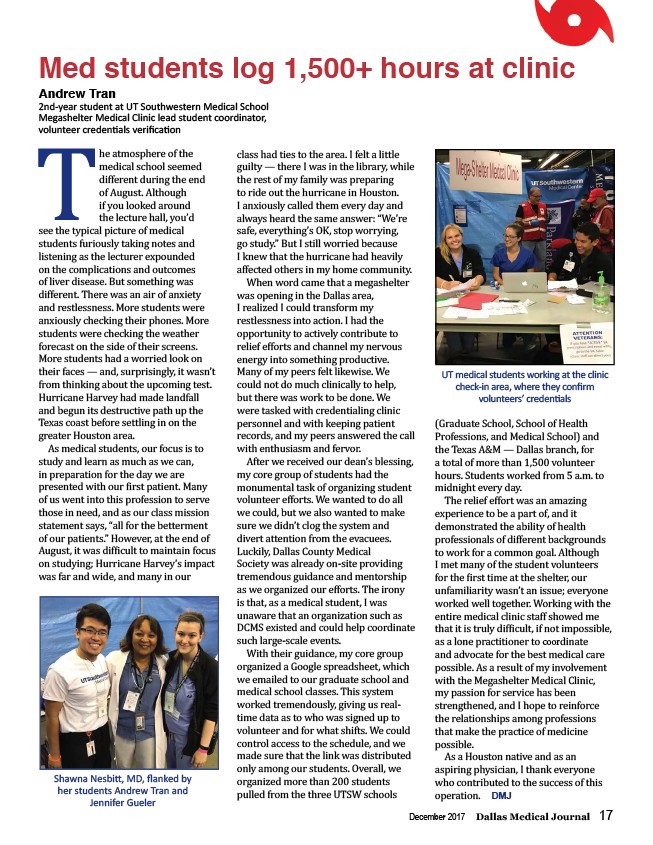
Med students log 1,500+ hours at clinic
December 2017 Dallas Medical Journal 17
he atmosphere of the
medical school seemed
different during the end
of August. Although
if you looked around
the lecture hall, you’d
see the typical picture of medical
students furiously taking notes and
listening as the lecturer expounded
on the complications and outcomes
of liver disease. But something was
different. There was an air of anxiety
and restlessness. More students were
anxiously checking their phones. More
students were checking the weather
forecast on the side of their screens.
More students had a worried look on
their faces — and, surprisingly, it wasn’t
from thinking about the upcoming test.
Hurricane Harvey had made landfall
and begun its destructive path up the
Texas coast before settling in on the
greater Houston area.
As medical students, our focus is to
study and learn as much as we can,
in preparation for the day we are
presented with our ��irst patient. Many
of us went into this profession to serve
those in need, and as our class mission
statement says, “all for the betterment
of our patients.” However, at the end of
August, it was dif��icult to maintain focus
on studying; Hurricane Harvey’s impact
was far and wide, and many in our
class had ties to the area. I felt a little
guilty — there I was in the library, while
the rest of my family was preparing
to ride out the hurricane in Houston.
I anxiously called them every day and
always heard the same answer: “We’re
safe, everything’s OK, stop worrying,
go study.” But I still worried because
I knew that the hurricane had heavily
affected others in my home community.
When word came that a megashelter
was opening in the Dallas area,
I realized I could transform my
restlessness into action. I had the
opportunity to actively contribute to
relief efforts and channel my nervous
energy into something productive.
Many of my peers felt likewise. We
could not do much clinically to help,
but there was work to be done. We
were tasked with credentialing clinic
personnel and with keeping patient
records, and my peers answered the call
with enthusiasm and fervor.
After we received our dean’s blessing,
my core group of students had the
monumental task of organizing student
volunteer efforts. We wanted to do all
we could, but we also wanted to make
sure we didn’t clog the system and
divert attention from the evacuees.
Luckily, Dallas County Medical
Society was already on-site providing
tremendous guidance and mentorship
as we organized our efforts. The irony
is that, as a medical student, I was
unaware that an organization such as
DCMS existed and could help coordinate
such large-scale events.
With their guidance, my core group
organized a Google spreadsheet, which
we emailed to our graduate school and
medical school classes. This system
worked tremendously, giving us realtime
data as to who was signed up to
volunteer and for what shifts. We could
control access to the schedule, and we
made sure that the link was distributed
only among our students. Overall, we
organized more than 200 students
pulled from the three UTSW schools
(Graduate School, School of Health
Professions, and Medical School) and
the Texas A&M — Dallas branch, for
a total of more than 1,500 volunteer
hours. Students worked from 5 a.m. to
midnight every day.
The relief effort was an amazing
experience to be a part of, and it
demonstrated the ability of health
professionals of different backgrounds
to work for a common goal. Although
I met many of the student volunteers
for the ��irst time at the shelter, our
unfamiliarity wasn’t an issue; everyone
worked well together. Working with the
entire medical clinic staff showed me
that it is truly dif��icult, if not impossible,
as a lone practitioner to coordinate
and advocate for the best medical care
possible. As a result of my involvement
with the Megashelter Medical Clinic,
my passion for service has been
strengthened, and I hope to reinforce
the relationships among professions
that make the practice of medicine
possible.
As a Houston native and as an
aspiring physician, I thank everyone
who contributed to the success of this
operation. DMJ
Andrew Tran
2nd-year student at UT Southwestern Medical School
Megashelter Medical Clinic lead student coordinator,
volunteer credenti als verifi cati on
Shawna Nesbitt , MD, fl anked by
her students Andrew Tran and
Jennifer Gueler
UT medical students working at the clinic
check-in area, where they confi rm
volunteers’ credenti als
T